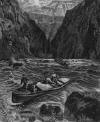As the Great Moundbuilder Debate continued the United States
government removed most of the Native American people West of the
Mississippi River. The policy called the Indian Removal Act of 1830 led to
forced removal often called the "Trail of Tears". Most
were relocated to the Indian Territory (later Oklahoma). After
the Civil War, nation building continued to encourage exploration and expansion
of
the Western Frontier, that moved beyond the Mississippi River to the
Pacific Ocean. John Wesley Powell (a Civil War Veteran who lost his right arm
at Shiloh) embarked on many explorations in the West including a trip down the Colorado River in wooden boats in 1869. In 1879 Powell became the director of the Smithsonian Institution's: Bureau
of Ethnology (later Bureau of American Ethnology/BAE) and the U.S.
Geological Survey/USGS. Powell assigned Cyrus Thomas to the Division of
Mound Exploration in 1882 to resolve the Great Moundbuilder Debate. Thomas'
findings were published in 1894.
In 1879 Powell became the director of the Smithsonian Institution's: Bureau
of Ethnology (later Bureau of American Ethnology/BAE) and the U.S.
Geological Survey/USGS. Powell assigned Cyrus Thomas to the Division of
Mound Exploration in 1882 to resolve the Great Moundbuilder Debate. Thomas'
findings were published in 1894.
Earthwork, Warren Co., Ohio, 1890
Similar work was conducted by Frederic Ward Putnam (1839-1915) the Curator of the Peabody Museum of American Archaeology and Ethnology, Harvard University, Cambridge, MA. In both cases results of systematic excavation revealed evidence that there were at least three mound building cultures. American Indian culture traits were present in the mounds, and some strata produced European trade items. Although, this evidence resolved the debate, it would take the public much longer to realize that these complex cultures were part of ancient Native America. Removal rendered Native Americans out of site and out of mind. The end of the 19th century and beginning of the 20th century brought the development of anthropological museums and departments throughout the U.S. Frederic Ward Putnam was instrumental in establishing a number of anthropology departments including University of California with A.L. Kroeber in 1903. These anthropology departments begin to develop archaeological field schools and began to gather better data about ancient Native American cultures.
Oldest{ Paleo-Indian/Lithic : ancient Pleistocene hunters and gatherers (H&G)
Archaic: post Pleistocene hunters and gatherers; early horticulture;
Formative: horticulture/agriculture; village and sedentary lifestyle
Classic: agriculture; urban city states and empire-building
Youngest{ Post- Classic: agriculture; empires becoming imperialistic
Such classifications can be useful but very controversial especially in terms of the Eurocentric evolutionary implications as well as the restrictions imposed by such typologies on entire cultural milieu. Cultural models are also needed to put together a reconstruction of any ancient culture based upon archaeological data. This data is organized in terms of a hierarchy of terms ( see also: Text-Fagan Table 2-2):
COMPONENT: stratigraphic unit from one site
PHASE: similar components from different sites
HORIZON: Common phases from different regions
These concepts imply data (artifacts, assemblages of tools, structures, sites) in time and space. Larger concepts include : Culture Areas; Sub-Areas; Archaeological Regions. A Cultural Tradition implies common lifestyles over time, e.g. Archaic Tradition. However, a Cultural Period, e.g. Late Archaic Period usually has specific time and space limitations (9,000-1,000 BCE/11,000-3,000 BP Eastern Woodlands). Unfortunately archaeologists are not always consistent in their own use of these terms. American archaeologists also began to examine context in terms of functional-structural approaches to cultural assessments.
| Explanatory Period 1960- |
